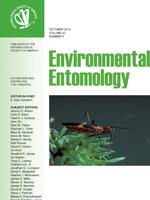Few studies compare how different soil fertilization practices affect plant mineral content and insect performance in organic systems. This study examined: 1) The European corn borer, Ostrinia nubilalis (Hübner), larval response on corn (Zea mays L.) grown in field soils with different soil management histories; and 2) resilience of these plants to O. nubilalis herbivory. Treatments included: 1) standard organic— organically managed soil fertilized with dairy manure and 2 yr of alfalfa (Medicago sativa L.) in the rotation; 2) basic cation saturation ratio—organically managed soil fertilized with dairy manure and alfalfa nitrogen credits, plus addition of gypsum (CaSO4·2H2O) according to the soil balance hypothesis; and 3) conventional—conventionally managed soil fertilized with synthetic fertilizers. Corn plants were reared to maturity in a greenhouse, and then infested with 0–40 O. nubilalis larvae for 17 d. O. nubilalis exhibited negative competitive response to increasing larval densities. Mean development time was significantly faster for larvae consuming basic cation saturation ratio plants than those on standard organic plants, with intermediate development time on conventional plants. Neither total yield (number of kernels) nor proportion kernels damaged differed among soil fertility treatments. Soil nutrients differed significantly in S and in Ca:Mg and Ca:K ratios, but principal components analysis of plant tissue samples taken before O. nubilalis infestation showed that S, Fe, and Cu contributed most to differences in plant nutrient profiles among soil fertility treatments. Results demonstrate that different fertilization regimens can significantly affect insect performance within the context of organic systems, but the effects in this study were relatively minor compared with effects of intraspecific competition.
How to translate text using browser tools
1 October 2014
Conventional and Organic Soil Fertility Management Practices Affect Corn Plant Nutrition and Ostrinia nubilalis (Lepidoptera: Crambidae) Larval Performance
Ebony G. Murrell,
Eileen M. Cullen
ACCESS THE FULL ARTICLE
It is not available for individual sale.
This article is only available to subscribers.
It is not available for individual sale.
It is not available for individual sale.

Environmental Entomology
Vol. 43 • No. 5
October 2014
Vol. 43 • No. 5
October 2014
basic cation saturation ratio hypothesis
European corn borer
larval competition
micronutrient
organic farming




